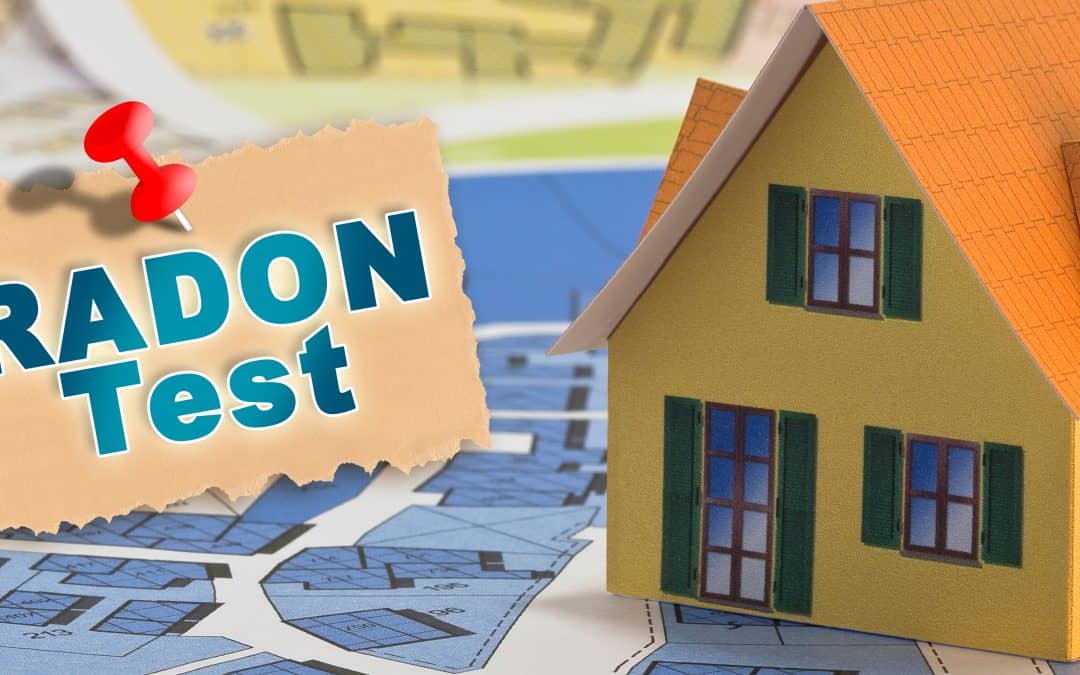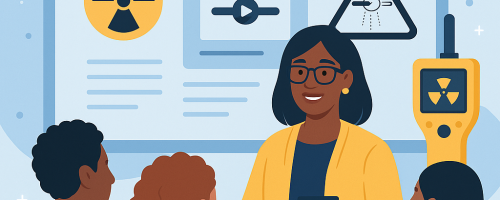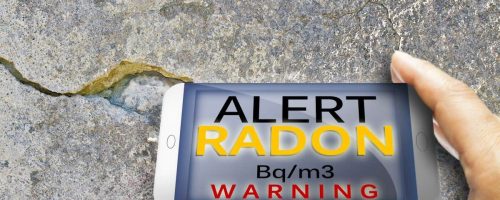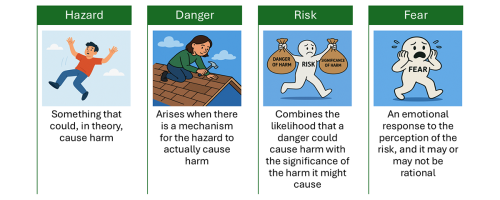Radon is a naturally occurring radioactive gas that can potentially escape into your home from the soil and rock beneath it[1]. Points of entry to your home usually involve seeping of the gas through cracks or around pipes and drains or via open piping like those bringing water to sump pumps, and occasionally from household use of water that has high radon levels. Homes in Canada are typically well sealed and insulated to trap heat indoors during the winter period. If radon enters the home, this can result in increased radon concentrations in homes[2]. While there are 3 naturally occurring isotopes of radon, the most concerning is radon-222 as it has the longest half-life of 3.8 days.
Radon-222 is part of the uranium-238 decay series, and since uranium-238 is commonly found in rocks all over the world, we end up with radon gas being created all over the Earth. As it is a gas, it can come up out of the rocks and ground. As radon decays, it forms several more short-lived radioactive atoms known as short-lived radon daughters which attach to dust and other particles and can be inhaled into the lungs. When radon and its short-lived daughter products decay, the atoms give off an alpha particle, which is very damaging to human tissue and is a known carcinogen. Consequently, elevated levels of radon gas exposure are the leading cause of lung cancer among non-smokers in Canada, and the second leading cause of lung cancer overall[3]. The International Agency for Research on Cancer (IARC) has classified radon as a Group 1 carcinogen, meaning it is known to be carcinogenic to humans[4]. It is estimated that more than 3,000 Canadians die every year from radon exposure.
Health Canada recommends that remedial measures be undertaken in a dwelling whenever the average annual radon concentration exceeds 200 Bq/m³ in a normal occupancy area[5] [6]. This guideline for radon includes residential homes and public buildings with a high occupancy rate by members of the public, such as schools, hospitals, long term care residences, and correctional facilities. To protect occupants from radon exposure, the guideline urges building owners to test the air within their buildings for radon and take appropriate action to reduce elevated radon levels to below the Canadian guideline for exposure to radon. The guideline advises that if radon concentration is found to be greater than 600 Bq/m³, then remedial actions[7] are recommended to be completed in less than a year. If radon concentrations are between 200 Bq/m³ to 600 Bq/m³, then remedial actions should be completed in less than two years. Excluded from this guideline are uranium mines regulated by the Canadian Nuclear Safety Commission (CNSC), other mines (regulated by provincial mining authorities) and other workplaces which would be addressed by existing guidelines for Naturally Occurring Radioactive Materials (NORM)[8].
Radon has no colour or odour and cannot be detected by human senses. The only way to know if your home or facility has high radon levels is to test it using a reliable device. There are several types of radon monitors available on the market, ranging from professional-grade devices that are certified by the Canadian National Radon Proficiency Program (C-NRPP)[9] to consumer-grade devices that are not certified. The C-NRPP oversees the national certification program of certified measurement professionals and mitigation professionals and ensures the quality and professionalism of radon services in Canada[10]. Since 2019, Pam Warkentin, Executive Director of the C-NRPP and the Canadian Association of Radon Scientists and Technologists (CARST) in collaboration with Brian Bjorndal, Director of the Radiation Safety Institute of Canada (RSIC) Fergal Nolan National Laboratories located in Saskatoon, have participated in an ongoing study evaluating the performance of consumer-grade electronic radon monitors that are sold online or in stores in Canada[11]. The purpose of the study was “to compare the performance of the different consumer-grade electronic radon monitors and determine which factors should be considered when using these monitors to inform mitigation decisions.” The study strived to comprehensively measure the accuracy, precision, and reliability of consumer grade electronic monitors under different test conditions at the RSIC’s National Radon Chamber[12].
The study analyzed three sample units of six different models of consumer grade electronic radon monitors (from three separate manufacturers). Four simulations were carried out, the first two test conditions targeted potential radon concentrations at 200 Bq/m³ to align with the Canadian guideline, adjusting the chamber’s environment to account for temperature and relative humidity associated with indoor winter and summer conditions, respectively. The last two rounds of testing accounted for elevated radon concentration at 400 Bq/m³ and 1000 Bq/m³ with the chamber simulating indoor winter conditions. The RSIC operates the first Canadian accredited secondary reference radon chamber approved under the American Association of Radon Scientists and Technologists (AARST) National Radon Proficiency Program (NRPP). The 12 m³ walk-in chamber can control radon levels over a wide range of concentrations, from 150 Bq/m³ to 500 000 Bq/m³. For quality control, radon concentrations and environmental conditions within the chamber are measured hourly during testing. To ensure traceability and harmonized testing of radon concentrations, the Canadian national laboratory participates annually in inter-comparison measurements with the Bowser-Morner radon reference chambers laboratory[13].
Overall, the study concluded that the six tested consumer grade monitors performed acceptably, as received after purchase. The study did not assess how these consumer grade monitors would perform over a timeframe of several years, so their long-term use acceptability is still unknown. It is important to note that professional grade monitors undergo routine quality control procedures that ensure accurate measurement results and are often equipped with features not available with consumer grade monitors. Therefore, long-term use of monitors used by professionals would ensure to be accurate if testing your home.
For more information about the C-NRRP study, please see our Radiation Protection and Wellness Webinar on this topic given on November 30, 2023. A link to the webinar recording of the session and supplementary material including links to resources mentioned in the presentation are found on our website at https://radiationsafety.ca/services/webinars/#RSW. In the Q&A section of the webinar, the Director of the C-NRPP/CARST provided a link where every Canadian can access a loan program for radon monitoring in their homes through a designated provincial library[14].
The study culminated in publications of a 2023 intercomparison report[15] along with a radon reduction sweepstakes report[16] as part of a four-year ongoing testing of consumer grade electronic radon detectors. A list of the devices recommended and not recommended by the C-NRPP can be found in the intercomparison report14. As noted in this report, electronic monitors provide results quickly, but radon levels can vary significantly from day to day and week to week. Short term measurements can be misleading, often being much lower or much higher than the average level, and it is the average exposure that is representative of the long-term radon risk and which should be compared to the guideline level. It is important to obtain a long-term measurement of at least 3 months in duration, in order to get an accurate representation of the average radon level. The report provides some guidelines for testing for radon, including the recommendation to test during the heating season when indoor radon levels are typically the highest. It goes on to recommend that if you don’t have access to a digital detector for 91 days or longer, to follow up with a long-term radon test kit. If you used such a test kit this winter, consider this your reminder that the weather is warming up and therefore it is time to package the test kit up and send it in for analysis.
[1] See https://radiationsafety.ca/radon-gas/ or https://www.canada.ca/en/health-canada/services/environmental-workplace-health/reports-publications/radon-what-you-need-to-know.html for more information on radon gas
[2] A fact sheet on radon can be obtained here: https://radiationsafety.ca/wp-content/uploads/2009/05/radon_factsheet.pdf
[3] Canadian Cancer Statistics, November 2023, Government of Canada. Report available from: https://cdn.cancer.ca/-/media/files/research/cancer-statistics/2023-statistics/2023_pdf_en.pdf
[4] IARC Classifications can be found here: https://monographs.iarc.who.int/list-of-classifications
[5] The Department of Health is given permission to publish objectives, guidelines or practices, under Subsection 55 (3) of the Canadian Environmental Protection Act, 1999.
[6] The Canadian guideline for radon can be found at Health Canada’s website: https://www.canada.ca/en/health-canada/services/environmental-workplace-health/radiation/radon/government-canada-radon-guideline.html
[7] Health Canada’s Radon Reduction Guide for Canadians can be found here: https://www.canada.ca/en/health-canada/services/environmental-workplace-health/reports-publications/radiation/radon-reduction-guide-canadians-health-canada.html
[8] The Canadian Guidelines for the Management of Naturally Occurring Radioactive Materials (NORM) can be found here: https://www.canada.ca/en/health-canada/services/publications/health-risks-safety/canadian-guidelines-management-naturally-occurring-radioactive-materials.html
[9] C-NRPP website is found here: https://c-nrpp.ca/
[10] The C-NRPP list of registered professionals can be found here: https://c-nrpp.ca/professionals/
[11] The study paper can be found here: https://iopscience.iop.org/article/10.1088/1361-6498/ab96d6
[12] Information on the RSIC radon chamber can be found here: https://radiationsafety.ca/laboratory-services/radon-chamber/
[13] https://www.bowser-morner.com/radon-reference-lab
[14] The loan program list can be accessed here: https://takeactiononradon.ca/resources/lending-programs/
[15] The report can be downloaded from this site: https://c-nrpp.ca/wp-content/uploads/2023/10/Digital-Device-Report-Oct-2023.pdf
[16] An explanation of the project and a link to the report can be found here: https://takeactiononradon.ca/radon-reduction-sweepstakes-report-2020-2021/







